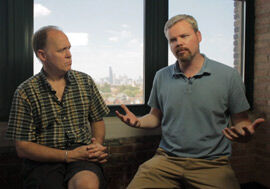
Onward and Upward

by Anjulie Rao (MA 2014)
Location, location, location. Nonprofit organizations hunt for the optimal geography in which their work will make the most impact, taking into consideration constituent locations, public visibility, and ability to easily collaborate with other groups. For Project Onward, a nonprofit organization run by SAIC alum Rob Lentz (MFA 1997)—with SAIC faculty member Randy Vick (Art Therapy) as a consultant—that works with artists with emotional and developmental disabilities, location has not only been crucial to meeting its mission, but has also been symbolic of changes in national attitudes regarding individuals with disabilities.
Eight years ago, Lentz was working in Gallery 37 with a small group of Chicago Public Schools students with emotional disabilities. As these students aged out of the program, he realized that if continued support was not provided, these students would discontinue making art. "We marshalled our resources, and started Project Onward in a small classroom in Gallery 37 without a huge agenda about what the program was going to be," says Lentz.
After some months, Lentz realized that finding a larger space would allow them to build a more directed, effective program. He states, "We realized that there was a huge need for people with all kinds of disabilities of the mind: mental illness, autism, Down syndrome—disabilities that would prevent someone with an artistic temperament from being able to be an artist."
In 2005 a classroom in the back of the Chicago Cultural Center became available to Project Onward. Though it was larger, difficulties of visibility continued. Then, in 2008, a public space on the first floor of the Cultural Center opened up—giving new meaning and possibility to the project.
"That changed everything; for the first time we had a permanent space to exhibit, and the artists were working in a public environment. Visitors would interact with the artists...and it turned out to be amazing and very positive. It opened up new possibilities, from the types of art they were making, to the types of programming," says Lentz.
From producing small, curated exhibitions to a popular public portrait program, the first floor space in the Cultural Center increased their visibility and allowed the artists to work directly with the public.
Today, Project Onward is again on the move—this time to the Bridgeport Art Center (BAC). According to both Vick and Lentz, the Cultural Center gave the organization new opportunities, but the BAC will offer their constituents unmatched opportunities to collaborate with working artists, curate an entire gallery, expand their technical training past two-dimensional media, and participate in a booming arts community.
Most importantly, the 10 years of relocating has symbolized the rapid change in how the public views people with disabilities. As Project Onward moved from back-room classrooms to a public space in a major institution, and now integrating into a working artist community, its home bases have mimicked how disability has continued to become something that is openly discussed and embraced. Vick states poignantly, "Typically, disability has been seen as something you hide away. I think the geographies of Project Onward have reflected change; it tore through prejudices and misconceptions of people with disabilities."
Project Onward will open in the Bridgeport Art Center, 1200 West 35th Street, Chicago, in September 2013. Learn more at projectonward.org.
